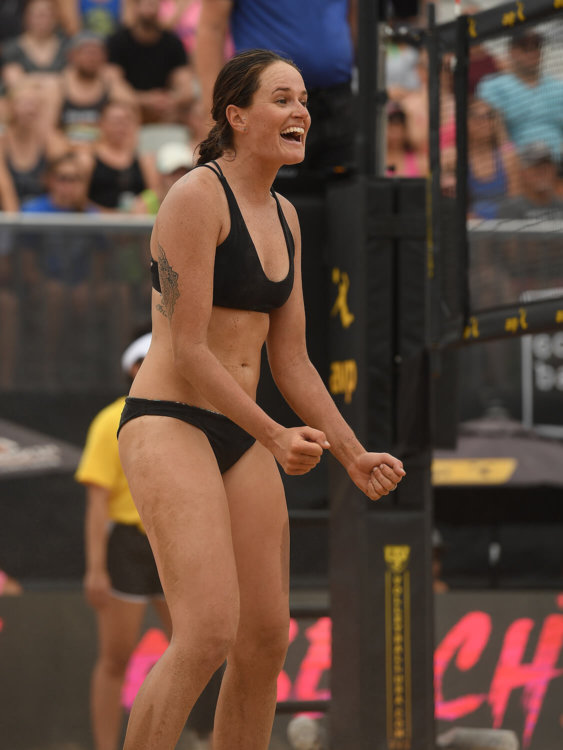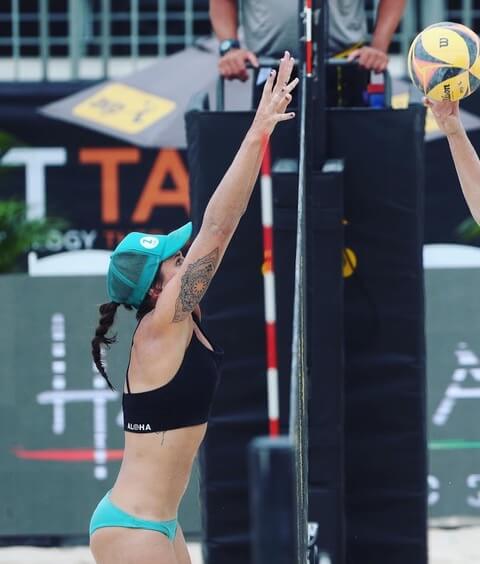There are essentially two styles of beach volleyball teams.
- Blocker/Defender – One player is the sole blocker. During service, they run up to the net after they serve or line up at the net and give calls while their partner serves. They also return to the net after every attack by either teammate. The defender is responsible for the rest of the court. They play defense behind their blocker. Almost every team on the AVP is like this – Phil/Nick; April/Alex; etc.
- Split blocking – Players switch off blocking and defending responsibilities. During service, the non-server stays at the net and blocks the first ball while the other teammate plays defense. After an attack, whichever player hits the ball becomes the blocker. This means during a rally, both teammates could be the blocker multiple times. Examples on the AVP like this – Tri/Trevor; Karissa/Jace

This brings me to our next Strategy Specialist: Karissa Cook.
Karissa has participated in about every form of volleyball – indoor player, full-time blocker, split blocker, and beach coach. Originally from Santa Cruz, Karissa first played as a setter for the Stanford indoor team (she’s super smart, hence the Stanford degree and machine-building she likes to do for fun). After graduating, Karissa played a fifth year at the University of Hawaii. At UH, she earned All-American honors and made it to the National Championship. From 2015 to 2018, Cook was the assistant coach for the beach volleyball team at Stanford before moving to LA to pursue competing on the AVP tour full time.
Karissa won her first AVP tournament last year in Austin, split-blocking with partner Jace Pardon. The two later went on to win the USA’s first gold medal in beach volleyball at the Pan American Games in Lima, Peru. You saw their split blocking strategy at the Champions Cup Series, let’s learn a little more about it.
KS – How does strategy differ between defender/blocker vs. split blocking?
KC- I think that one of the most overlooked advantages of split blocking is the different looks it gives to the opposing team’s offense. Typically, over the course of a match, you start to pick up on what the blocker and defender’s tendencies and strategies are, i.e. how they are timing their blocks, how often they choose to pull off the net, or how much a defender will cheat in the backcourt. When both players are blocking and defending, often times switching during the course of a rally, it’s less obvious which tendencies are associated with each player when you are attacking.
When split blocking, which position do you prefer?
I personally love blocking and the cat and mouse game that comes with it. I love showing one thing and trying to take another, or trying to be sneaky with a late or fake pull (Note: pulling is when a blocker leaves the net and pulls back to dig instead of blocking). It’s like tiny, fast-paced chess up there, and as a smaller blocker (puller) I definitely have to have my brain and body working quickly to disrupt the opposing attacker. Jace is also a natural defender and reads the game extremely well from the backcourt, so most matches we will start with her serving to get her on defense to start. I love defense too and hope to keep learning it, but after blocking for three years on tour to start my AVP journey, I’m still slightly more comfortable up at the net.

What advantage does a split blocking team have? Same question for defender/blocker teams?
I’d say that one other advantage of a split blocking team is the ability to cover for each other in a long tiring rally without ever being out of position. It also saves energy when you don’t have a blocker running from the service line to get to the net or racing across the court to set up the defense every time a partner hits a sharp cut that gets dug – split-blockers get to hang out in position more often and call for help when we need it.
A disadvantage of split-blocking is that there can occasionally be a bit of vagueness when both players think it’s their turn to run up to block or get back on defense. We occasionally find ourselves without a blocker up, trying to dig some very talented attackers who now have an open net (channeling the Lindquist sisters). A blocker/defender team also has the ability to specialize more in practice, and more specialized players get double the reps on defense or blocking that split-blockers do. As two medium-sized humans we give up a lot of verticality at the net: you can hit a high-line a lot faster over us than someone like an Alix Klineman or Sarah Pavan, so we have to get creative.
Which style of play do you prefer?
I might have a slight preference for split blocking, but if I’m playing with someone who I mesh well with I’m happy to play any role. And by “mesh with” I mostly mean someone who can take mediocre passes and turn them into perfect sets. I need those these days.
What’s your favorite strategy aspect of beach volleyball?
My favorite strategy in beach volleyball is giving myself and my partner the green light to take risks. Volleyball is by far the most fun when you have the trust with your partner to color outside the lines, be it with bump-overs (boops), options, reading on defense, serving for aces, or going for the occasional stuff block instead of just ’taking your area’. Those tend to be the moments you remember too.